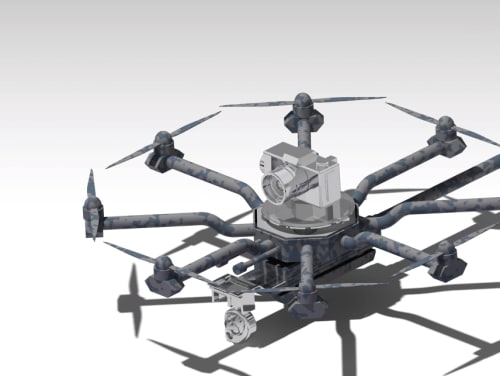2022
Aerospace & Defense
During training for or in emergency response situations,
This entry presents a novel hybrid biologically-inspired dual-reciprocating and oscillation drill and sampler. The proposed system combines both reciprocation motion bioinspired by the wood wasp ovipositor and a new undulatory/oscillation motion bioinspired by the caudal fins of marine creatures, (which use this motion to generate a thrust force to propel themselves through water),
This is an unmanned aerial vehicle (AUV) that was inspired by the drone Alta 8. There are two cameras, one for an aerial view and another for ground.
Cargo Containers are lashed together to form 600ft x 320ft flight deck (192,000 sq ft), 2-hanger decks (180,000 sq ft/deck) & (9,000,000 cuft volume), 2-pontoons Catamaran hulls (600 ft x120 ft x 50ft), 10,000 tons cargo capacity, 10,000 tons Control Ship (Fletcher Class DD, or Arleigh Burke Class DDG, etc), 5,000 tons fuel,
Hypersonic flight is closer than you think!
Space Engine Systems' mission is to push the boundaries of sustainable hypersonic flight and space accessibility at the lowest cost. To achieve this goal, a reusable demonstration piloted aircraft, optional unmanned, is being designed and built that can take-off as a conventional aircraft,
Space Engine Systems Inc. (SES), headquartered in Edmonton, Canada, is currently building the HELLO-1 Experimental, a Mach 5 Hypersonic vehicle using Air Breathing Turbo-Ramjet engines. The vehicle is undergoing full scale ground testing in preparation for flight testing this year.
The biggest challenge to success in hypersonic flight, for both commerce and defence, is heat.
Debris in orbit is a growing problem. Moving at roughly Mach 25, even a loose screw can inflict catastrophic damage if it collides with a small satellite, creating more debris that can impact other spacecraft. Efforts to deal with this have treated debris as trash,
The presented concept of an inertial drive, a spaceship-robot, enables the development of backlight speeds and very high accelerations and, which is very important, also delays, i.e. the practical braking of the ship when approaching the planet. Currently, the recoil force is used to propel spacecraft, which has its limitations in the achievable speed and range of rockets.
Flight delays and cancellations due to weather, cost commercial aviation dearly. Landing is the most safety critical part of flight. Landing in low visibility conditions, characterized as Cat II & III in aviation terminology, requires a very elaborate set of facilities and lots of real estate.
Page 3 of 6









